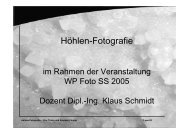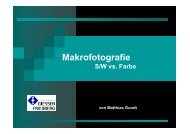Mathematik für Ingenieure (Teil 1) - Fachbereich 13 MND
Mathematik für Ingenieure (Teil 1) - Fachbereich 13 MND
Mathematik für Ingenieure (Teil 1) - Fachbereich 13 MND
Sie wollen auch ein ePaper? Erhöhen Sie die Reichweite Ihrer Titel.
YUMPU macht aus Druck-PDFs automatisch weboptimierte ePaper, die Google liebt.
U. Abel, <strong>MND</strong>: Ingenieurmathematik WS 2006/07 6<br />
2. a m b m = (a b) m ;<br />
3. (a m ) n = a m n :<br />
Bemerkung:<br />
Satz 1.8 gilt auch <strong>für</strong> m; n 2 R (siehe später).<br />
1.2.3 Logarithmen<br />
Eigenschaften des Logarithmus:<br />
Logarithmus x = log a c (a; c > 0) ; falls a x = c:<br />
Wegen a 0 = 1 ist log a 1 = 0:<br />
Wegen a 1 = a ist log a a = 1:<br />
a log a x = x <strong>für</strong> alle x > 0,<br />
log a a x = x <strong>für</strong> alle x 2 R.<br />
Für beliebige x; y > 0; q 2 R gilt<br />
log (x y)=log x + log y und log x q = q log x.<br />
Basis a = 10 Dekadischer Logarithmus log 10 x = lg x<br />
Basis a = e Natürlicher Logarithmus log e x = ln x<br />
(Eulersche Zahl e = 2; 718281 : : :)<br />
Basis a = 2 Zweierlogarithmus log 2 x = lbx<br />
speziell: x = ln ex ; x = eln x und x = lg 10x ; x = 10ln x
















